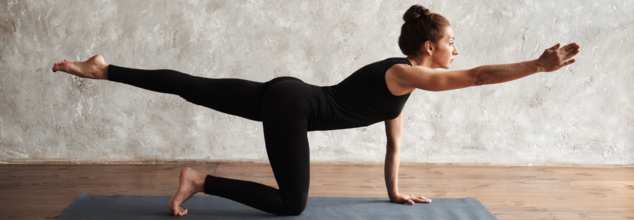- Health Conditions A-Z
- Health & Wellness
- Nutrition
- Fitness
- Health News
- Ayurveda
- Videos
- Medicine A-Z
- Parenting
- Web Stories
Yikes! Your Brain ‘Eats Itself’ During This Common Workout

Image Credit: Canva
Ever pushed yourself so hard during a workout that you were completely drained? Well, here's something crazy—if you're running marathons or doing high-intensity endurance activities, your brain may be literally eating itself! Sounds terrifying, right? But don't panic just yet. Scientists have learned that with long endurance activities, when glucose stores are low, your brain begins to break down its own fat stores—namely, myelin, the insulating sheath around nerve fibers.
Before you swear off running for good, here's the best part: your brain is tough! This phenomenon, known as metabolic myelin plasticity, can actually keep your brain going even when you're stressed. So what does this do for athletes and fitness enthusiasts? Let's explore the science behind this strange phenomenon and how it impacts your brain health.
For those who test their bodies to the limit with intense endurance training such as running marathons, there's an incredible biological process going on—your brain begins to eat itself. However, before you jump into a panic, let's see why and how this happens, what it signifies, and why it may not be as scary as it seems.
Why Does the Brain Begin to Eat Itself?
A revolutionary study in Nature Metabolism illuminates what occurs within the brains of marathon runners. During distance running, marathon runners exhaust their main fuel source—glucose. In response, the brain adjusts by breaking down a different energy source: myelin. Myelin is a fatty covering that envelops nerve fibers, allowing for the quick transmission of signals from neuron to neuron. This phenomenon, termed metabolic myelin plasticity, highlights how the brain temporarily repurposes its own components to keep functioning under extreme physical exertion.
Researchers took brain scans of 10 marathon runners before and after a competition. Within 24 to 48 hours after the race, their brain scans showed a significant drop in myelin content, especially in white matter areas responsible for motor control and emotion integration. This self-devouring of myelin is a desperate survival mechanism, keeping the brain alive when energy levels are at their lowest.
How Long Does Myelin Loss Last?
The better news? The brain does not suffer permanent damage. The same research determined that levels of myelin started to repair themselves within two weeks following the marathon. But it took two months for the levels to fully stabilize. Although this short-term reduction is unlikely to lead to permanent neurological damage, it does temporarily impair cognitive function, including slower response times and reduced memory soon after severe endurance exercise.
What This Means for Endurance Athletes?
For decades, neuroscientists accepted the idea that the brain mostly shunned using fat as a fuel, even in dire straits. This research pushes back on that idea, proposing that myelin acts as a metabolic safety net—a backup source of fuel the brain can draw upon when glucose critically dips.
The results are in accordance with existing studies on animals, especially mice, where myelin was established to be an emergency energy reservoir. Although more research is necessary to establish the long-term consequences in humans, the findings of the study are that our brains have developed the backup system in order to survive physically stressful tasks.
Is it a Survival Mechanism?
From an evolutionary perspective, this function may have been essential for early humans. The use of myelin may have enabled our forebears to go for prolonged periods of time on hunts without losing mental responsiveness, enabling them to pursue and catch prey over the course of many hours. The observation that highly developed regions of the brain have more myelin implies that it has played an important part in human survival and development.
Possible Hazards and Consequences for Brain Health
While the brain's capacity for myelin breakdown is intriguing, repeated or excess myelin breakdown may have effects. Myelin is crucial for nervous system functioning, and degeneration of the myelin has been associated with neurological disorders such as multiple sclerosis. Yet, in healthy people, this transitory depletion does not appear to have significant long-term consequences.
That said, individuals engaging in frequent extreme endurance activities should be mindful of their brain health. Ensuring proper recovery periods, maintaining a balanced diet rich in brain-supporting nutrients, and staying hydrated can all help mitigate potential risks associated with myelin depletion.
Balancing Endurance Training With Good Brain Health
If you’re an endurance athlete, here are some practical takeaways to support brain function while training:
Prioritize Recovery: Provide your body and brain with sufficient time to recover from lost myelin before attempting another intense workout.
Fuel Properly: Eat a diet filled with healthy fats, proteins, and complex carbohydrates to stay at optimal energy levels.
Monitor Cognitive Performance: If you experience ongoing brain fog, memory loss, or enduring fatigue following endurance activities, seek advice from a healthcare provider.
Integrate Cross-Training: Combining endurance exercise with strength training or yoga may curb extended stress to the brain and nervous system.
New Research Links Narrowed Visual Attention To Faster Running Pace

Credits: Canva
If you’re aiming to improve your running speed and endurance, it may be time to shift your gaze — quite literally. A new study suggests that narrowing your focus while running, especially as you near the finish line, can help you move faster and push harder.
The research, published on June 25 in the journal Personality and Social Psychology Bulletin, looked at the performance of nearly 1,600 runners across six separate studies. Conducted by researchers from Rutgers University, New York University, and Creighton University, the findings point to a low-cost and highly effective strategy known as “attentional narrowing.”
Put simply, runners who directed their gaze straight ahead — instead of looking around — not only moved faster but also exerted more physical effort.
Attentional Narrowing: What the Science Says
“The findings offer a low-cost and simple way to improve running performance — merely by adjusting how we direct our attention,” said Dr. Shana Cole, associate professor of psychology at Rutgers University-New Brunswick.
In the study, both elite and casual runners were surveyed and tested. Some participants were asked to maintain a narrow focus throughout their run, while others were instructed to shift their attention only in the final stretch. The races varied between 400 meters and one mile, but the result was consistent: those who fixed their eyes on a single point ahead — like the finish line — ran faster and registered higher heart rates, indicating increased effort.
“Looking at one spot ahead of you — rather than around you — can help you keep going,” added lead author Emily Balcetis, associate professor of psychology at New York University.
Co-author Corey Guenther, psychology professor at Creighton University, emphasized that the mental strategy doesn’t just correlate with better results — it causes them. “The studies show that narrowing attention isn’t just correlated with performance. It actively enhances it,” he said.
Why Running Is Already Good for You
This simple mental tweak could make running even more beneficial — and that’s saying something. Running is well-known for its wide-ranging health perks. According to a 2019 study published in the British Journal of Sports Medicine, even small amounts of running (as little as once a week) are associated with a significantly lower risk of death from all causes, including cardiovascular disease and cancer.
Running also helps with weight control, strengthens the heart, improves sleep, and releases endorphins — the feel-good hormones — which help reduce stress and anxiety. The Centers for Disease Control and Prevention (CDC) recommends at least 150 minutes of moderate-intensity aerobic activity per week for adults, and running is a quick and efficient way to meet that goal.
The Takeaway: Pick a Spot and Go for It
The study findings offer a practical, science-backed takeaway: when running, particularly in challenging stretches, resist the urge to look around. Instead, fix your eyes on a point ahead — a tree, a marker, or the finish line — and stay focused.
As Balcetis explained, “A simple shift in attention can lead to better outcomes — mentally and physically.”
So the next time you're out on a run, remember: where your eyes go, your legs may just follow.
15-Minute Yoga Poses That Will Energize You For The New Week

(Credit-Canva)
After a nice, relaxing weekend, going back to work can feel hard. Thinking about Monday mornings and all your tasks can make you miss your easy weekend days.
Unlike other exercises that push you hard and often leave you feeling drained and tired, yoga energizes you differently. It works by waking up your body, calming your mind, and improving your breathing, which helps you feel refreshed and focused without feeling worn out.
Start Your Week With Energizing Yoga
To help you get rid of any leftover weekend laziness and feel fresh, clear, and ready for your work, try a quick yoga routine. These 15-minute yoga poses are made to give your body and mind energy, helping you start the new week feeling lively and positive.
Cat-Cow Pose
This gentle movement, flowing from hands and knees as you arch your back like a cow then round it like a cat, warms up your entire spine, making it more flexible and improving blood flow. It deeply connects your breathing with your movement, which helps you feel more awake and aware, promoting a sense of calm readiness to start your practice.
Downward-Facing Dog
From hands and knees, lifting your hips high to form an inverted "V" stretches your whole body, from your legs to your shoulders. As a mild inversion, it sends fresh blood to your brain, which helps you feel more alert, clear-headed, and gives you a good energy boost to start your day.
Sun Salutation
This flowing series of poses, including standing tall, bending forward, plank, and gentle backbends, serves as a complete warm-up for your entire body. It builds gentle heat inside and gets your energy moving throughout, perfectly matching your movements with your breath to calm your mind while energizing your body, preparing you well for whatever the week brings.
Warrior II
Stepping your feet wide, turning one foot out and bending that knee while extending your arms, is a strong standing pose that builds inner strength and helps you focus your mind. It opens up your hips and chest, giving you a feeling of expansiveness and vitality, helping you cultivate a strong, confident presence for the week ahead.
Tree Pose
Standing tall and balancing on one leg with the other foot placed on your inner ankle, calf, or thigh, this pose greatly improves your balance and concentration, very helpful for quieting a busy mind. It makes you feel steady, grounded, and stable, ideal for cultivating a calm yet energized presence, preparing you for a focused and balanced new week.
Seated Twist
Sitting with one leg bent and crossing over the other, then gently twisting your upper body, is excellent for stimulating your internal organs, aiding in cleansing and better digestion. It also wakes up your spine and can release any built-up tension, leaving you feeling refreshed and lighter in both body and mind.
Easy Pose with Breathwork
Sitting comfortably cross-legged with closed eyes, focusing on deep, steady breaths helps integrate all the benefits of the poses. This mindful breathing calms your nervous system, leaving you feeling truly centered and mentally clear, ultimately preparing you to face the new week with renewed energy and a peaceful mind.
Train Your Core The 'Right Way' With This 15-Minute Standing Abs Workout

Credits: Youtube/@Madfit
When it comes to building a strong, functional core, most people instinctively think of sit-ups or crunches. A strong core is foundational to total-body strength and stability but when it comes to core training, not all ab exercises are created equal. While floor crunches have long been a staple in the fitness community, trainers and enthusiasts alike are pivoting toward a more dynamic and effective approach: standing core workouts.
This isn’t just about aesthetic abs. Standing ab workouts engage more muscles, improve balance, and reflect the way we use our core in daily activities. Fitness expert and YouTuber Maddie Lymburner, shared a workout video on Youtube emphasizes, "I believe in training the core while standing because it forces the abs and the other midsection muscles to engage to keep you stable."
A standing abs routine mimics how your core works in daily life—stabilizing, balancing, and powering your every movement. Here’s how you can transform your core training with Maddie’s dynamic, equipment-friendly 15-minute standing abs workout.
Why Standing Core Workouts Is Better Than Crunches?
Traditional floor exercises like crunches and sit-ups isolate the rectus abdominis, but they don’t fully engage the muscles that stabilize your spine and pelvis during real-world activities. Standing workouts, on the other hand, challenge your entire core—including the obliques, transverse abdominis, and lower back—by forcing your body to balance, twist, and resist gravity.
“Training your core while standing means your abs have to work the way they’re meant to work,” Maddie explains. “You’re not just lying down; you’re engaging your muscles to keep you upright, balanced, and strong.”
One of the best things about this routine is its accessibility. “You can use a dumbbell, a kettlebell, or whatever you have access to at home. It will work fine,” Maddie reassures. “Make sure that you can see your screen so you can follow along with me.”
The 15-Minute Standing Abs Workout, Round One
1. Single-Arm Dumbbell Marches
Start by holding a dumbbell in your right hand, lifting your right leg up, and lowering it slowly. This move tests your core stability and balance. Switch sides and repeat.
2. Standing Twists with Dumbbell
With a slight bend in your knees, hold the dumbbell in both hands and twist from side to side. "You're going to feel the resistance from the weight. We're going to work those obliques," says Lymburner.
3. Oblique Crunches with Dumbbell
With the dumbbell in your right hand, slide it down your leg and return to center. Then raise the weight overhead and lean to the opposite side. Repeat and switch arms. This move targets your side core muscles like no other.
4. Diagonal Leg Lifts
Holding the dumbbell above your head with both hands, bring one knee diagonally across your body and then open it to the side. "Bring that knee up as close as you can to your chest, and then to the side," Lymburner instructs. Repeat with the other leg.
5. Woodchoppers
Starting from a low position, bring the dumbbell up diagonally across your body while bracing your core. Repeat on both sides. "Think about using your core to move the body up, not your arms," says Lymburner.
6. Standing Elbow-to-Knee Crunches
Place your fingertips near your ears, bring your knee and elbow together at your center. This simple move is effective for working the entire midsection.
7. Dumbbell Passes Around the Waist
Pass the dumbbell around your body from one hand to the other. The trick is to stabilize your core so the rest of your body doesn’t sway. Go one direction in Round One and switch in Round Two.
Standing core exercises are rooted in functional fitness—the idea that training should prepare your body for real-life movements. Research shows that standing ab routines activate more muscle groups, improve posture, and boost calorie burn compared to traditional floor exercises. They also enhance balance, coordination, and athletic performance, making them ideal for everyone from beginners to seasoned athletes.
Tips for Getting the Most Out of Your Standing Abs Workout
Focus on Form: Keep your movements controlled and your core braced throughout each exercise.
Breathe: Exhale during the effort phase (e.g., lifting the knee or twisting) to maximize core engagement.
Start Light: Use a light weight to master technique before progressing to heavier loads.
Stay Consistent: Incorporate this routine 2–3 times per week for best results.
So the next time you think of core workouts, skip the mat. As Maddie Lymburner shows us, just a pair of dumbbells and 15 minutes can power up your posture, balance, and abs more efficiently than any crunch circuit ever could.
Disclaimer: Always consult with a healthcare provider before beginning any new exercise program, especially if you have any pre-existing conditions or injuries.
© 2024 Bennett, Coleman & Company Limited

